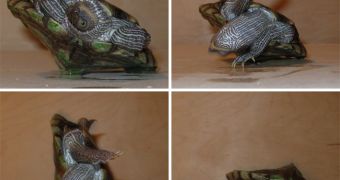Living trapped in a bony shell must be tough. But what if you fall on your back? For a turtle, this is impossible not to happen, as males fighting for females often flip their adversaries on their back. Still, this may not kill the animal, as it will get on its feet on its own. A new research solved the mystery: it's all in the shell's shape, leg and neck maneuvers.
This also explains the somehow bizarre shapes found in some turtles: "Before starting this project, I always thought animals such as turtles worked hard to right themselves, and what this showed was this need not be the case-they can just have a good shape for their shell that does most of the work", applied mathematician Peter Varkonyi at the Budapest University of Technology and Economics in Hungary told LiveScience.
Aquatic turtles have flatter shells fit for swimming, and to get back on their normal position, they push their heads against the ground employing the powerful muscles, levering themselves onto their abdomens.
But the land turtles possess hard bony high-domed shells, an effective protection against predators, but this makes their necks and limbs not to reach the ground for leverage when flipped on the back.
Varkonyi, together with Gabor Domokos, analyzed the geometry of 30 shells coming from 17 aquatic and terrestrial chelonian species, and discovered that the height, width and curvature of high-domed tortoise shells always fitted into an optimal range that allows them to right on their own. The shell places the weight of a turtle into a pattern that decreases the energy consumed by the turtle in moving its head or feet to roll down.
High-domed shells, such as the star tortoise Geochelone elegans, can get stuck due to small imperfections in the shell shape, but just a weak leg-wagging can turn the tortoise right. Tall shells with a single stable resting orientation (on the tortoise's feet) are monostatic. "No real chelonian has a perfectly monostatic shell, probably because tall shells could have disadvantages too: you could be rolled over by wind, for instance. Also, he says, it takes quite a bit of fine-tuning to achieve a truly monostatic shape." said V?rkonyi.
Moderately domed shells, such as the Terrapene box turtles, present 3 stable positions (!): on the back, on the front or halfway between: this requires a mix of both strategies: moving their head or feet turns the shell from the back-down position to the sideways position, and from that position, the neck pivot can be employed. "We'd like to see if there are beetles like this also", Varkonyi said.

 14 DAY TRIAL //
14 DAY TRIAL //